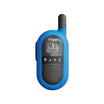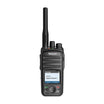For professional users, digital two-way radio in licensed bands is the wave of the future. Whether they’re using analog radio today, or looking to implement their first two- way radio system, business organizations of all kinds will soon be choosing their first digital two-way radio solutions. The advantages and opportunities are simply too great to ignore — in transportation, education, construction, manufacturing, energy and utilities, private security, small municipalities and many other industries.
For most enterprises in these professions, TDMA provides the best method for achieving 6.25 kHz equivalent efficiency in licensed 12.5 kHz channels:
• TDMA is being leveraged in European and U.S. standards initiatives aimed at providing greater spectral efficiency for the land mobile radio market.
• Unlike FDMA methods of rebanding existing channels into discrete 6.25 kHz channels, properly designed two-slot TDMA systems fit cleanly into existing channel structures, with no rebanding or relicensing necessary.
• TDMA improves capacity today, while offering a path to compliance with further channel efficiency requirements that may be mandated in the future.
• Because it increases capacity without the need for additional repeaters and other infrastructure, TDMA can lower the overall costs of implementing digital two-way radio.
• TDMA offers the performance and flexibility to support the functional requirements of mobile professionals in virtually any industry.
For most enterprises in these professions, TDMA provides the best method for achieving 6.25 kHz equivalent efficiency in licensed 12.5 kHz channels:
• TDMA is being leveraged in European and U.S. standards initiatives aimed at providing greater spectral efficiency for the land mobile radio market.
• Unlike FDMA methods of rebanding existing channels into discrete 6.25 kHz channels, properly designed two-slot TDMA systems fit cleanly into existing channel structures, with no rebanding or relicensing necessary.
• TDMA improves capacity today, while offering a path to compliance with further channel efficiency requirements that may be mandated in the future.
• Because it increases capacity without the need for additional repeaters and other infrastructure, TDMA can lower the overall costs of implementing digital two-way radio.
• TDMA offers the performance and flexibility to support the functional requirements of mobile professionals in virtually any industry.









































